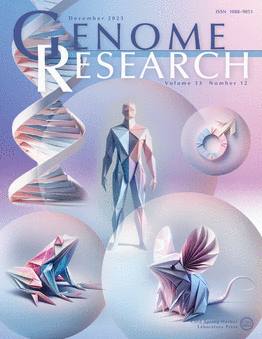Dynamic evolution of satellite DNAs drastically differentiates the genomes of Tribolium sibling species
IF 5.5
2区 生物学
Q1 BIOCHEMISTRY & MOLECULAR BIOLOGY
引用次数: 0
Abstract
Tandemly repeated satellite DNAs (satDNAs) are among the most abundant and fastest-evolving eukaryotic sequences, but the way they model genomes is still elusive. Here, we investigate the evolutionary dynamics of satDNAs in the extremely satDNA-rich genomes of two closely related Tribolium insects that produce sterile hybrids. In Tribolium freemani, we identify 135 satDNAs, accounting for 38.7% of the genome. Comparative analysis with the Tribolium castaneum satellitome reveals that the drastic difference occurred in their centromeric regions, which share orthologous organization characterized by totally different major satDNAs but related minor satDNAs. The T. freemani male sex chromosome, which lacks the major satDNA but contains a minor-like satDNA, further highlighted the question of which satDNA is centromere-competent. By analyzing the long-range organization of the centromeric regions, we discover that both the major and minor satDNA arrays exhibit a strong tendency toward macro-dyad symmetry, suggesting that the secondary structures in the centromeres may be more important than the primary sequence itself. We find evidence that the centromeric satDNAs of T. freemani occur in extrachromosomal circular DNAs, which may contribute to their expansion and homogenization between nonhomologous chromosomes. We also identify numerous low-copy-number satDNAs that are orthologous between the siblings, some of which are associated with transposable elements, highlighting transposition as a mechanism of their spreading. The dynamic evolution of satDNAs has clearly influenced the differentiation of Tribolium genomes, but the question remains whether the differences in their satDNA profiles are a cause or consequence of speciation.卫星dna的动态进化极大地区分了Tribolium兄弟物种的基因组
串联重复卫星dna (satdna)是最丰富和进化最快的真核生物序列之一,但它们模拟基因组的方式仍然难以捉摸。在这里,我们研究了两个密切相关的产生不育杂交的Tribolium昆虫的极其丰富的satdna基因组中的satdna的进化动力学。在Tribolium freemani中,我们鉴定出135个satdna,占基因组的38.7%。与Tribolium castaneum卫星组的比较分析表明,它们的着丝粒区存在着巨大的差异,它们具有同源组织,主要的satdna完全不同,但次要的satdna却相关。T. freemani男性性染色体缺少主要的辅助dna,但包含一个类似次要的辅助dna,这进一步突出了哪个辅助dna具有着丝粒能力的问题。通过分析着丝粒区域的远程组织结构,我们发现主、次卫星dna阵列都表现出强烈的宏观双体对称趋势,这表明着丝粒中的二级结构可能比一级序列本身更重要。我们发现有证据表明,T. freemani的着丝粒satdna发生在染色体外的环状dna中,这可能有助于它们在非同源染色体之间的扩增和均匀化。我们还发现了许多同源的低拷贝数satdna,其中一些与转座因子相关,突出了转座作为其传播的机制。satDNA的动态进化显然影响了Tribolium基因组的分化,但问题仍然是它们的satDNA谱的差异是物种形成的原因还是结果。
本文章由计算机程序翻译,如有差异,请以英文原文为准。
求助全文
约1分钟内获得全文
求助全文
来源期刊

Genome research
生物-生化与分子生物学
CiteScore
12.40
自引率
1.40%
发文量
140
审稿时长
6 months
期刊介绍:
Launched in 1995, Genome Research is an international, continuously published, peer-reviewed journal that focuses on research that provides novel insights into the genome biology of all organisms, including advances in genomic medicine.
Among the topics considered by the journal are genome structure and function, comparative genomics, molecular evolution, genome-scale quantitative and population genetics, proteomics, epigenomics, and systems biology. The journal also features exciting gene discoveries and reports of cutting-edge computational biology and high-throughput methodologies.
New data in these areas are published as research papers, or methods and resource reports that provide novel information on technologies or tools that will be of interest to a broad readership. Complete data sets are presented electronically on the journal''s web site where appropriate. The journal also provides Reviews, Perspectives, and Insight/Outlook articles, which present commentary on the latest advances published both here and elsewhere, placing such progress in its broader biological context.
 求助内容:
求助内容: 应助结果提醒方式:
应助结果提醒方式:


